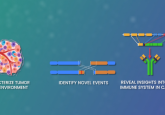Single-cell analysis with nanopore sequencing

The study of genomic and transcriptomic information at the single-cell level has provided novel insights into various research areas, particularly cancer research. Traditional short-read sequencing, which is commonly used in single-cell assays, requires transcript fragmentation when generating single-cell libraries, so only a small region close to one end of a transcript is available for analysis. This limited representation means important information about the transcript can be missed. Nanopore sequencing, on the other hand, does not require fragmentation. Long nanopore sequencing reads can cover full-length transcripts in single reads, including spanning repetitive regions, structural variants and splicing events.
In this In Focus, in association with Oxford Nanopore, we will explore the use of nanopore sequencing in single-cell analysis studies, and how it can be used to provide important insights into tumor biology.


